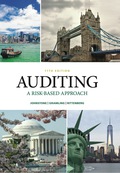
EBK AUDITING: A RISK BASED-APPROACH
11th Edition
ISBN: 9781337670203
Author: RITTENBERG
Publisher: YUZU
expand_more
expand_more
format_list_bulleted
Question
Chapter 6, Problem 12CYBK
To determine
Introduction: Audit evidence is proof that an auditor tries to seek from an organization in order to claim that the assertions related to financial transactions are correct.
The statement which is untrue regarding substantive analytical procedure.
Expert Solution & Answer
Trending nowThis is a popular solution!

Students have asked these similar questions
Please provide the accurate answer to this general accounting problem using valid techniques.
hello teacher please give me correct answer
Nova Inc. sets a standard of 6.5 hours per unit
at $18 per hour. It produces 2,500 units,
actually using 16,900 hours at a rate of $19 per
hour.
Find:
(a) Labor rate variance
(b) Labor time variance
(c) Labor cost variance
Chapter 6 Solutions
EBK AUDITING: A RISK BASED-APPROACH
Ch. 6 - Prob. 1CYBKCh. 6 - Prob. 2CYBKCh. 6 - Prob. 3CYBKCh. 6 - Which of the following statements is true...Ch. 6 - Prob. 5CYBKCh. 6 - Prob. 6CYBKCh. 6 - Prob. 7CYBKCh. 6 - Prob. 8CYBKCh. 6 - Prob. 9CYBKCh. 6 - Prob. 10CYBK
Ch. 6 - Prob. 11CYBKCh. 6 - Prob. 12CYBKCh. 6 - Prob. 13CYBKCh. 6 - Prob. 14CYBKCh. 6 - Prob. 15CYBKCh. 6 - Prob. 16CYBKCh. 6 - Prob. 17CYBKCh. 6 - Prob. 18CYBKCh. 6 - Prob. 19CYBKCh. 6 - Prob. 20CYBKCh. 6 - Prob. 1RQSCCh. 6 - Prob. 2RQSCCh. 6 - Prob. 3RQSCCh. 6 - Prob. 4RQSCCh. 6 - Refer to Exhibit 6.2 and describe the differences...Ch. 6 - Prob. 6RQSCCh. 6 - Prob. 7RQSCCh. 6 - Prob. 8RQSCCh. 6 - Prob. 10RQSCCh. 6 - Prob. 11RQSCCh. 6 - Prob. 12RQSCCh. 6 - Prob. 13RQSCCh. 6 - Prob. 14RQSCCh. 6 - Prob. 15RQSCCh. 6 - Indicate how the auditor could use substantive...Ch. 6 - Prob. 17RQSCCh. 6 - Prob. 18RQSCCh. 6 - Prob. 19RQSCCh. 6 - Prob. 20RQSCCh. 6 - Prob. 21RQSCCh. 6 - Prob. 22RQSCCh. 6 - Prob. 23RQSCCh. 6 - Prob. 24RQSCCh. 6 - Prob. 25RQSCCh. 6 - Prob. 26RQSCCh. 6 - Prob. 27RQSCCh. 6 - Prob. 28RQSCCh. 6 - Prob. 29FFCh. 6 - Prob. 30FFCh. 6 - Prob. 31FFCh. 6 - Prob. 32FFCh. 6 - Prob. 33FFCh. 6 - MINISCRIBE (LO 1, 2) As reported in the Wall...
Knowledge Booster
Similar questions
arrow_back_ios
SEE MORE QUESTIONS
arrow_forward_ios
Recommended textbooks for you
 Auditing: A Risk Based-Approach (MindTap Course L...AccountingISBN:9781337619455Author:Karla M Johnstone, Audrey A. Gramling, Larry E. RittenbergPublisher:Cengage Learning
Auditing: A Risk Based-Approach (MindTap Course L...AccountingISBN:9781337619455Author:Karla M Johnstone, Audrey A. Gramling, Larry E. RittenbergPublisher:Cengage Learning Auditing: A Risk Based-Approach to Conducting a Q...AccountingISBN:9781305080577Author:Karla M Johnstone, Audrey A. Gramling, Larry E. RittenbergPublisher:South-Western College Pub
Auditing: A Risk Based-Approach to Conducting a Q...AccountingISBN:9781305080577Author:Karla M Johnstone, Audrey A. Gramling, Larry E. RittenbergPublisher:South-Western College Pub

Auditing: A Risk Based-Approach (MindTap Course L...
Accounting
ISBN:9781337619455
Author:Karla M Johnstone, Audrey A. Gramling, Larry E. Rittenberg
Publisher:Cengage Learning

Auditing: A Risk Based-Approach to Conducting a Q...
Accounting
ISBN:9781305080577
Author:Karla M Johnstone, Audrey A. Gramling, Larry E. Rittenberg
Publisher:South-Western College Pub